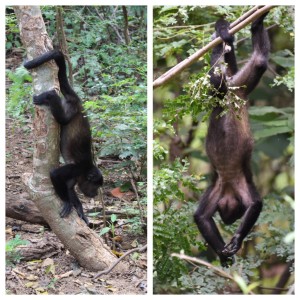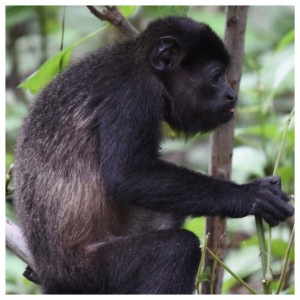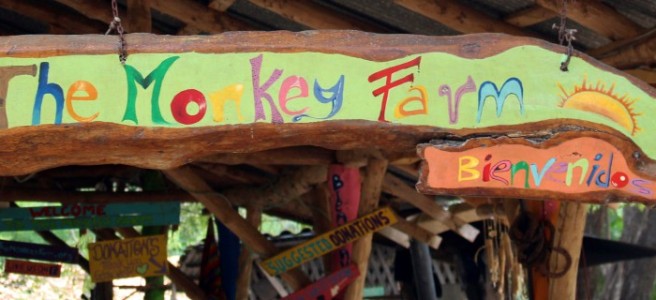My Love and I had a look on the internet for somewhere to visit and found a rescue centre for monkey’s called The Monkey Farm near Playa Ocotal. Reading the blurb it sounded as if it would be worth a visit and we would have the opportunity to see some of the different types of monkeys that they help rescue and rehabilitate. The only thing that I thought was strange was the news on the side of their webpage seemed very out of date but maybe they’d had a problem with the internet – we’ve all been there.
 It didn’t show up on the Sat Nav, although this isn’t unusual in Costa Rica as we have found out but we knew that it was near Playa Ocotal and that did show up so we headed off. The drive there was enjoyable and as we got nearer to Playa Ocotal we saw small wooden brightly hand painted signs that said Monkey Farm, after a couple of guesses as the signs petered out or more likely we missed them we left the main road for a dirt road.
It didn’t show up on the Sat Nav, although this isn’t unusual in Costa Rica as we have found out but we knew that it was near Playa Ocotal and that did show up so we headed off. The drive there was enjoyable and as we got nearer to Playa Ocotal we saw small wooden brightly hand painted signs that said Monkey Farm, after a couple of guesses as the signs petered out or more likely we missed them we left the main road for a dirt road.
All I can say is it is a good job it wasn’t raining and that we were in a 4 x 4, the road was pretty bad and at one point it seemed to disappear. As we drove up an incline we saw a tree covered with hanging blue bottles and a painted tyre monkey. I think we had arrived.
We got out and headed towards an open barn structure, the only other people we could see was a family who were obviously visitors who left soon after we arrived so we had the place to ourselves which seemed a little strange.
 There was a box for donations as we entered and a book for visitors to sign in. On the left were open pens which held goats including a pair of newly born kids, on the right was an open barbecue and table where three people were cutting up vegetables in preparation for cooking a meal.
There was a box for donations as we entered and a book for visitors to sign in. On the left were open pens which held goats including a pair of newly born kids, on the right was an open barbecue and table where three people were cutting up vegetables in preparation for cooking a meal.
Out of nowhere a girl appeared in front of us, very enthusiastic and welcoming and started talking about the goats. She was an American, this was her second stint at volunteering and she obviously was wanting to show off her knowledge.
What we didn’t realise at this point was that she was our self-appointed guide for our tour, although due to its size I’m not sure that we needed one. ML does not like guides, in fact it would be safe to say that he hates the experience, he likes to wander at his own pace, make up his own mind and ask questions if needed.
This was not to be the case unfortunately.
As we passed through the barn structure there was a white board prominently on display, written on it was a list of equipment the centre needed also a list of the volunteers, their age and country of origin and the date of their arrival. They seemed to come from all over the world and I guess from their ages that most of them were gap year students.
ML and I kept looking around for the monkey enclosures but they weren’t in evidence where we could see them. We thought that they were probably in another section, we were soon to learn that what we could see was it.
We were shown pigs, more goats and chickens. There was a couple of rabbits in a raised pen and a small hedgehog buried under some straw. We were also shown the duck ponds which we were told were being drained, their surface was a mass of thick green algae and I must admit I felt quite sorry for the ducks as that amount of algae had obviously taken some time to build up.
The website for the centre talks about sustainability in feeding the animals and the volunteers, what plants there were that we could see were all in the very early stages of growth. The volunteer showed us a potato tower which a previous volunteer from New Zealand had started as a project, it was looking a little sorry for itself but it was a good idea. Apparently some of the animals got into the aquaponics and ate all the plants so it’d had to be restarted also there was in a small garden near the rabbits a patch of ground growing plants using the concept of ‘3 Sisters’.
 As it was explained to us by the volunteer you grow beans, squash and corn together, the idea being the corn provides a structure for the beans to grow up, the beans provide nitrogen for the other plants and the squash covers the soil preventing weed growth. Whoever had started the garden hadn’t thought it through and all the plants had been planted at the same time, common sense tells you the corn needs to grow a bit first otherwise what happens to the beans.
As it was explained to us by the volunteer you grow beans, squash and corn together, the idea being the corn provides a structure for the beans to grow up, the beans provide nitrogen for the other plants and the squash covers the soil preventing weed growth. Whoever had started the garden hadn’t thought it through and all the plants had been planted at the same time, common sense tells you the corn needs to grow a bit first otherwise what happens to the beans.
There were obviously some very clever, committed volunteers who start the projects and they work on them for the length of their stay but once they leave responsibility for it doesn’t seem to get passed on. It is a real shame that things either become abandoned or the next person that works on them either doesn’t have the same expertise or the enthusiasm for it.
There is a very colourful structure just before you go into the open barn structure which is the composting toilet which I believe was only completed recently. To allow light in the structure they have used empty bottles similar to those hanging in the trees to make one of the walls of glass. There is a cabin with brightly painted chairs outside in which some of the volunteers lived, others were camping in the field behind the toilet.
We did get the opportunity to meet a young Howler Monkey, his mother had been killed and he was living at the centre. He was playing in the trees just outside the electric fence and was completely unfazed by our appearance. Both ML and I were able to photograph him playing and moving around. From what the volunteer told us he plays freely in the trees during the day but is housed at night – she didn’t say where though, and the hope is that he will join the local troop as a previous monkey called Madeline had.


We managed to stretch our visit to last an hour, it was a long way, about three hours driving there and back for one monkey. We see more monkeys at the bottom of our garden so we were a little disappointed by our visit.


But saying that if you want to visit a petting farm with the possibility of seeing a monkey then it is worth a visit, the volunteers are very enthusiastic, friendly and in some cases very knowledgeable. If you are hoping to see as we were mainly monkeys then I would suggest you look elsewhere.



